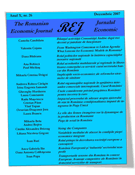Abstract:
The current paper aims to study the application of this theory in the current economic context in Romania, contributing to filling the gaps in the existing research on this subject. Thus, in the practical part of the paper, a non-linear regression model was created using the volume of greenhouse gases as the dependent variable (representing environmental degradation) and the GDP per capita as the independent variable (representing the economic development of the country). The results suggest a significant impact of economic development on environmental pollution in Romania between 1990 and 2022. The positive correlation between GDP per capita and greenhouse gas emissions, as indicated by the positive coefficient of DPIB (-1), underscores the importance of managing economic growth sustainably to mitigate environmental impacts. This finding aligns with Kuznets' environmental curve theory, which proposes that initially, rising per capita income can result in higher pollution and greenhouse gas emissions as developing nations prioritize economic advancement over environmental concerns. However, as economies progress and mature, there is an opportunity for the adoption of cleaner technologies, the implementation of environmental regulations, and investments in sustainability, potentially leading to a reduction in both greenhouse gas emissions and pollution.
